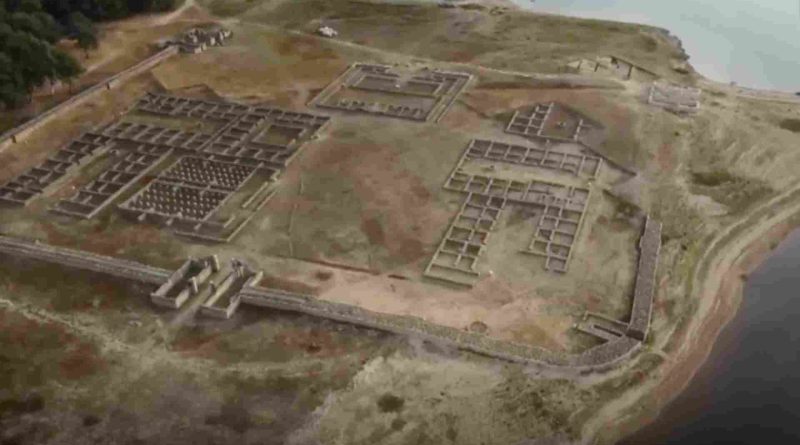Resurfacing Antiquity: Unveiling the Roman Ruins of Aquis Querquennis Amidst Europe’s Drought Crisis
Revealing from the depths of a drought-stricken European river after nearly two millennia, the resurfacing of Roman ruins captivates the eyes and minds alike.
In a remarkable series of photographs, the receding waters unveil the vast expanse of an ancient Roman military encampment, Aquis Querquennis, nestled along the Lima River in Galicia, Spain. This extraordinary occurrence comes amidst Europe’s grappling with an unprecedented drought and scorching temperatures.
Dating back to approximately 75 AD, the Romans initiated the construction of this military outpost, which served its purpose for about a century before its abandonment, as detailed by Spanish researchers in a 2018 study. Subsequently, the remnants of this once bustling camp were submerged following the erection of the As Conchas reservoir in 1949.
However, the parched conditions of this summer heralded the resurrection of antiquity.
The ghostly silhouette of the ancient encampment emerges from the riverbanks, its weathered remains standing in solemn testimony to the passage of time. Aerial vistas depict an intricate network of stone edifices, crafted with meticulous precision from gray-brown cobblestones. A vestige of a protective wall encircles the smaller structures, while a partially collapsed entrance hints at the grandeur that once defined this site.
Amidst the ruins, remnants of pillars, their summits long lost to the ages, adorn the weathered walls, while a solitary archway defiantly withstands the ravages of erosion. Nature, in its inexorable march, now adorns these ancient vestiges with a verdant embrace.
Known locally as “A Cidá” or “the city,” Aquis Querquennis once served as a bustling hub for up to 600 Roman soldiers. Within its precincts stood barracks, granaries, a hospital, a temple, and even thermal baths fueled by the region’s natural hot springs. It is said that offerings of spiritual significance were made by the Roman occupants into these sacred waters.
Centuries submerged beneath the waters, Aquis Querquennis resurfaces in its entirety as the As Conchas reservoir dwindles to 49% capacity. This resurgence of history unfolds amidst a backdrop of unprecedented climatic upheaval, with Spain and much of Europe grappling with soaring temperatures and dwindling rainfall.
The current drought, exacerbated by human-induced climate change, is deemed the most severe in at least half a millennium, with almost two-thirds of Europe under drought warnings or alerts. As rivers across the continent retreat, they unveil poignant relics of bygone eras – from “hunger stones” to WWII shipwrecks and ancient megalithic monuments.
Regrettably, the end of this parched ordeal seems distant, with forecasts suggesting persistently hot and arid conditions until November. The dire situation is set to worsen across several European nations, including Belgium, France, Germany, Hungary, Italy, Luxembourg, Moldova, the Netherlands, northern Serbia, Portugal, Romania, Spain, Ukraine, and the United Kingdom.
Aquis Querquennis, situated approximately 300 miles northwest of Madrid near the Spain-Portugal border, stands as a poignant testament to the interplay between human history and the capricious forces of nature.

